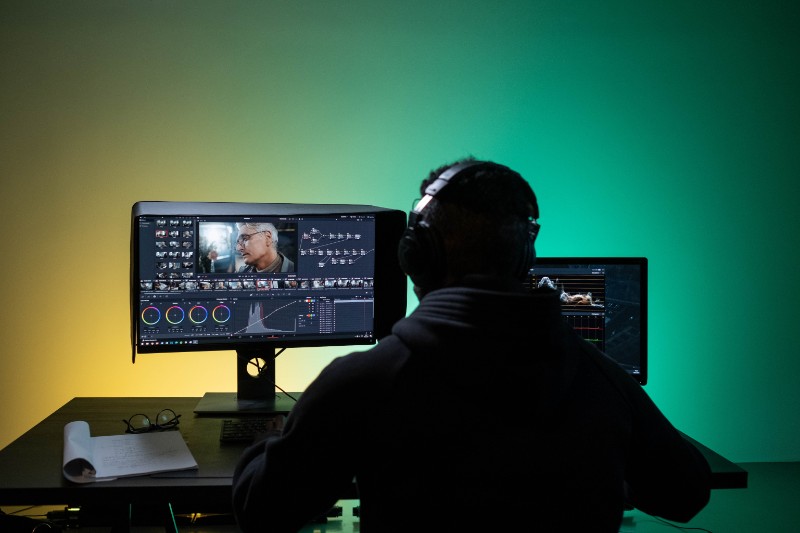Artificial intelligence is revolutionizing video editing and content creation. Gone are the days of painstakingly stitching together clips and transitions manually. AI-powered tools allow creators to generate stunning videos from simple text prompts or automatically edit raw footage into polished final products.
These AI video editors can dramatically speed up production while delivering professional-quality results. Tools like Runway, Wondercraft AI, and Canvas AI Video Editor harness machine-learning algorithms to handle complex editing tasks in minutes rather than hours. They can generate b-roll footage, add special effects, adjust pacing, and create new video content from scratch.
As AI capabilities continue advancing, the line between human-created and AI-generated video content blurs. Industry experts predict AI will soon be able to produce Hollywood-caliber visual effects and even generate lifelike synthetic actors. While some worry about potential job displacement, many see AI as a powerful tool that will augment human creativity rather than replace it. The future of video production looks to be an exciting fusion of human imagination and machine intelligence.

AI video editing and content creation tools are revolutionizing the way creators produce engaging visual content. These cutting-edge solutions leverage artificial intelligence to streamline and enhance various aspects of the production process.
Synthesia stands out as a leader in AI-powered video generation. It employs text-to-speech technology and deep learning algorithms to animate lifelike avatars, enabling users to create professional-looking videos without filming or hiring actors.
For podcast enthusiasts, Wondercraft AI offers an innovative approach. This platform transforms written content into high-quality audio productions with music and premium AI voices. It’s a game-changer for those looking to break into the podcasting world.
Fliki AI Video Generator provides content creators with the flexibility to produce visually appealing and impactful videos. Its user-friendly interface makes it accessible to both beginners and experienced creators alike.
Veed.io has emerged as a top choice for AI video editing, particularly for those new to the field. Its intuitive design and powerful features make it an excellent option for creators looking to enhance their video content.
Adobe Premiere Pro continues to be an industry staple, now incorporating AI-powered tools for seamless video and audio synchronization. This addition has cemented its position as a go-to solution for professional editors.
As AI technology advances, these tools are expected to become even more sophisticated, offering creators unprecedented video and audio production capabilities.
See Related: The AI-Assisted Side Hustle Revolution: How Hybrid AI is Transforming Freelance Work

AI video editing tools are revolutionizing content creation. They’re opening up new possibilities for creators to produce high-quality videos faster.
These tools can automatically generate scripts, storyboards, and even entire video sequences from text prompts. This frees up creators to focus on the big-picture creative vision.
Some AI video editors can remove backgrounds, add special effects, and even create realistic digital avatars. This allows for production value that was once only possible with big budgets and teams.
Content creators are using AI to repurpose their existing content into new formats. A blog post can become a video, or a long podcast can be turned into bite-sized clips for social media.
AI-powered tools also assist with tedious tasks like captioning, translation, and thumbnail creation, streamlining the post-production workflow considerably.
Industry experts predict AI will enable a new wave of hyper-personalized content. Videos could be automatically customized for different audience segments or even individual viewers.
While AI won’t replace human creativity, it’s becoming an indispensable assistant. The most successful creators will be those who learn to leverage these tools effectively.
See Related: AI and Your Wallet: Exploring Lucrative Careers in the AI Tech Field

A successful software-as-a-service (SaaS) product requires vision, strategy, and technical expertise. The journey begins with identifying a market need and validating the product idea through extensive research and user feedback.
Next comes the crucial design phase. User experience (UX) reigns supreme in SaaS, so intuitive interfaces and seamless workflows are paramount. Wireframes and prototypes help refine the product concept before diving into development.
The tech stack selection can make or break a SaaS venture. Cloud-native architectures using microservices are increasingly popular for their scalability and flexibility. Many startups opt for rapid development frameworks like Ruby on Rails or Node.js to accelerate time-to-market.
Security and data privacy can’t be afterthoughts. SaaS products often handle sensitive information, so robust encryption, access controls, and compliance measures are essential from day one.
Pricing models require careful consideration. Options include:
The launch is just the beginning. Successful SaaS products evolve continuously based on user analytics and feedback. Agile development practices enable rapid iterations and feature releases.
Marketing plays a pivotal role in SaaS success. Content marketing, SEO, and targeted ads help attract users. But nothing beats a polished product demo video to showcase the software’s value proposition.
See Related: Unlock the Power of AI: Turn ChatGPT into Your Cash Machine

AI is poised to revolutionize content creation across the creative industry. Video production, in particular, stands to benefit enormously from AI-powered tools. These technologies will assist creators with tasks ranging from ideation to editing, freeing up time for higher-level creative work.
One expert predicts, “By 2030, AI will be an indispensable collaborator for video producers, handling up to 50% of routine tasks.”
AI avatars are also set to transform on-screen performances. While they can’t fully replace human actors, they’ll open up new possibilities for storytelling and cost-effective production.
Generative AI models will speed up content creation workflows in marketing and design. Marketers might use AI to rapidly generate and test multiple ad concepts, while designers could iterate on visual ideas at lightning speed.
The music industry won’t be left behind. AI composition tools will assist songwriters, potentially uncovering novel melodic patterns and chord progressions.
• Key areas of AI impact:
As exciting as these developments are, human creativity will remain at the heart of the industry. AI will amplify human capabilities rather than replace them entirely.
Human Rights Watch Report 2023-09-04 15:32:23 -0700 PST: AI is developing faster than laws and ethics can keep up. This raises concerns about job displacement and copyright issues that society must address.
Last updated: September 13, 2024